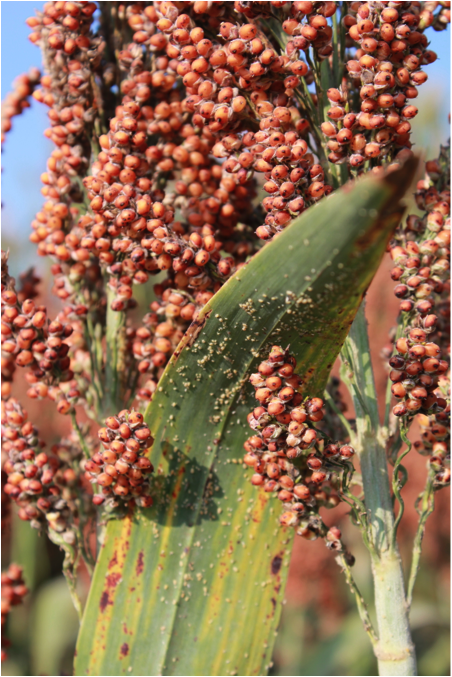This tip was provided by Ronnie Schnell, Ph.D., Cropping Systems Specialist, Texas A&M AgriLife Extension, College Station.
Central and North Central Texas
Sugarcane aphids that move from the lower plant canopy to the upper canopy (flag leaf or head) as harvest approaches could result in harvest problems. Honeydew produced by feeding aphids and sooty mold development can create sticky conditions that reduce the efficiency of harvest equipment. To control late-season infestations of sugarcane aphids, insecticides with reduced harvest intervals will be preferable. Transform® WG (sulfoxaflor) has demonstrated good control of sugarcane aphids and has a pre-harvest interval of 14 days. The harvest restriction mandates that fields be checked greater than 14 days before anticipated harvest to allow for application of the product without delaying harvest. Fields should be checked and plants can be flagged for follow up inspection in 2-3 days. If aphid numbers are high and are increasing, application of an insecticide may be warranted. While exact thresholds have not been determined yet, high aphid numbers per leaf (upper leaf after flowering) on 20% of plants may justify spraying. More information on monitoring and thresholds can be found at: http://ccag.tamu.edu/files/2014/07/Compilation_sorghum-aphid_IPM4.pdf.
In addition, proper application rate, carrier volume and coverage will be important for effective control of the aphid until harvest. And as always, read and follow label directions. Restrictions for Transform are listed below.
Restrictions:
- Pre-harvest Interval: Do not apply within 7 days of harvest for forage, and 14 days for grain or stover.
- A restricted entry interval (REI) of 24 hours must be observed.
- Do not make more than two applications per acre per year.
- Minimum Treatment Interval: Do not make applications less than 14 days apart.
- Do not apply more than a total of 3.0 oz of Transform WG (0.09 lb ai of sulfoxaflor) per acre per year.
In addition to insecticide sprays, other management practices can be employed to allow for efficient harvest when sugarcane aphids are present. Harvest aids can be used to eliminate feeding sites for aphids or to displace the aphids. If glyphosate is used, keep in mind that the herbicide works more slowly, gradually drying the plant. Displacement of aphids is uncertain. Glyphosate will kill the plant, so application timing and acreage sprayed must allow for timely harvest to avoid potential lodging. Other harvest aids, such as sodium chlorate, could be used to desiccate the plant and displace aphids. Sodium chlorate is applied 7-10 days before harvest and will dry the plant much quicker than glyphosate and does not kill the plant if lodging is a concern. If harvest is imminent and aphid populations are building, harvesting grain as soon as possible will be the best option.
Figure 1. Sugarcane aphid located on the flag leaf, head and lower leaves of physiological mature grain sorghum.










